Textbook Question
Rubidium iodide has a lattice energy of -617 kJ/mol, while potassium bromide has a lattice energy of -671 kJ/mol. Why is the lattice energy of potassium bromide more exothermic than the lattice energy of rubidium iodide?
1490
views
 Verified step by step guidance
Verified step by step guidance



Rubidium iodide has a lattice energy of -617 kJ/mol, while potassium bromide has a lattice energy of -671 kJ/mol. Why is the lattice energy of potassium bromide more exothermic than the lattice energy of rubidium iodide?
The lattice energy of CsF is -744 kJ/mol, whereas that of BaO is -3029 kJ/mol. Explain this large difference in lattice energy.
Use the Born–Haber cycle and data from Appendix IIB, Chapter 8 and this chapter to calculate the lattice energy of KCl. (ΔHsub for potassium is 89.0 kJ/mol.)
Write the Lewis structure for each molecule. a. PH3 b. SCl2 c. HI
Write the Lewis structure for each molecule. d. CH4